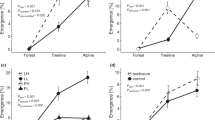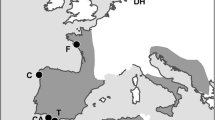Abstract
In heterogenous landscapes, seeds settle in some microsites more readily than others, independently of whether those microsites are suitable for germination and subsequent growth, and survival of seedlings. Wild seeds and seedlings of Ericameria nauseosa var. oreophila in the sand-dune ecosystem near Mono Lake, California show both concordance and conflict in where seeds are retained and where seedlings flourish. Using a field experiment, we followed performance of seeds and seedlings (i.e., the rate of germination and successful emergence, initial seedling size, seedling growth and survival over first growing season), by planting seeds of known sizes in pre-identified microsites (windward and lee aspects of interspaces between shrubs, under shrub canopies, and under snag canopies, respectively). Heavier seeds were more likely to germinate and emerge successfully and resulted in initially larger seedlings than lighter seeds. These initially larger seedlings subsequently remained larger over the growing season and lived longer than initially smaller seedlings. Independent of seed and initial seedling size, seedlings that germinated under the canopy of adult shrubs grew larger and survived longer than seedlings that germinated in interspaces (open space with little or no vegetation) or under snags (dead adult shrubs). Seedlings grown under the canopy of adult shrubs experienced significantly less solar radiation and wind-deposited sand than seedlings grown in interspace or snag microsites. Sand burial more than 1 cm was lethal for seedlings. The two variables of seed size and microsite type had by far greater impact on eventual growth and survival of seedlings than did aspect, and the effects of the former two variables were independent of each other. This study amplifies the body of work on E. nauseosa at this site demonstrating that the earliest events in the life history of this long-lived perennial shrub appear to persist through time despite the harsh and variable environment.



Similar content being viewed by others
References
Benard RB, Toft CA (2007) Effect of seed size on seed-seedling performance in a long-lived desert perennial shrub (Ericameria nauseosa: Asteraceae). Int J Plant Sci (in press)
Benard RB, Toft CA (submitted) Causes and consequences of spatial aggregation on seedling establishment of a desert perennial shrub (Ericameria nauseosa: Asteraceae)
Bonfil C (1998) The effects of seed size, cotyledon reserves, and herbivory on seedling survival and growth in Quercus rugosa and Q. laurina (Fagaceae). Am J Bot 85:79–87
Bowers JE (1996) Seedling emergence on Sonoran Desert dunes. J Arid Environ 33:63–72
Bowers JE, Turner RM, Burgess TL (2004) Temporal and spatial patterns in emergence and early survival of perennial plants in the Sonoran Desert. Plant Ecol 172:107–119
Brown JF (1997) Effects of experimental burial on survival, growth, and resource allocation of three species of dune plants. J Ecol 85:151–158
Caldwell MM (1985) Cold deserts. In: Chabot BF, Mooney HA (eds) Physiological ecology of North American plant communities. Chapman and Hall, New York, pp 198–212
Chambers JC (2000) Seed movements and seedling fates in disturbed sagebrush steppe ecosystems: implications for restoration. Ecol Appl 10:1400–1413
Dalling JW, Hubbell SP (2002) Seed size, growth rate and gap microsite conditions as determinants of recruitment success for pioneer species. J Ecol 90:557–568
de Villalobos AE, Pelaez DV (2001) Influences of temperature and water stress on germination and establishment of Prosopis caldenia Burk. J Arid Environ 49:321–328
Donovan LA, Mausberg J, Ehleringer JR (1993) Seedling size and survival for Chrysothamnus nauseosus. Great Basin Nat 53:237–245
Forseth IN, Wait DA, Casper BB (2001) Shading by shrubs in a desert system reduces the physiological and demographic performance of an associated herbaceous perennial. J Ecol 89:670–680
Fort KP, Richards JH (1998) Does seed dispersal limit initiation of primary succession in desert playas? Am J Bot 85:1722–1731
Fowler N (1986) The role of competition in plant communities in arid and semiarid regions. Ann Rev Ecol Syst 17:89–110
Fox GA (2001) Failure time analysis: studying time events and rates at which events occur. In: Scheiner SM, Gurevitch J (eds) Design and analysis of ecological experiments. Oxford University Press, pp 235–266
Franco AC, Nobel PS (1989) Effect of nurse plants on the microhabitat and growth of cacti. J Ecol 77:870–886
Goldberg DE, Turner RM (1986) Vegetation change and plant demography in permanent plots in the Sonoran Desert. Ecology 67:695–712
Gross KL (1984) Effects of seed size and growth form on seedling establishment of 6 monocarpic perennial plants. J Ecol 72:369–387
Gross KL, Kromer ML (1986) Seed weight effects on growth and reproduction in Oenothera biennis L. Bull Torrey Bot Club 113:252–258
Hastwell GT, Facelli JM (2003) Differing effects of shade-induced facilitation on growth and survival during the establishment of a chenopod shrub. J Ecol 91:941–950
Hendrix SD, Trapp EJ (1992) Population demography of Pastinaca sativa (Apiaceae) – effects of seed mass on emergence, survival, and recruitment. Am J Bot 79:365–375
Holmgren M, Scheffer M, Huston MA (1997) The interplay of facilitation and competition in plant communities. Ecology 78:1966–1975
Jurado E, Westoby M (1992) Seedling growth in relation to seed size among species of arid Australia. J Ecol 80:407–416
Lamont BB, Witkowski ETF, Enright NJ (1993) Postfire litter microsites – safe for seeds, unsafe for seedlings. Ecology 74:501–512
Leirana-Alcocer J, Parra-Tabla V (1999) Factors affecting the distribution, abundance and seedling survival of Mammillaria gaumeri, an endemic cactus of coastal Yucatan, Mexico. J Arid Environ 41:421–428
Leishman MR, Westoby M (1994) The role of seed size in seedling establishment in dry soil conditions – experimental evidence from semiarid species. J Ecol 82:249–258
Maun MA (1994) Adaptations enhancing survival and establishment of seedlings on coastal dune systems. Vegetatio 111:59–70
Maun MA (1998) Adaptations of plants to burial in coastal sand dunes. Can J Bot 76:713–738
McArthur ED, Meyer SE, Weber DJ (1987) Germination rate at low temperature – rubber rabbitbrush population differences. J Range Manage 40:530–533
McLeod KW, Murphy PG (1977) Establishment of Ptele trifoliata on Lake-Michigan sand dunes. Am Mid Nat 97:350–362
McLeod KW, Murphy PG (1983) Factors affecting growth of Ptelea trifoliata seedlings. Can J Bot 61:2410–2415
Meyer SE, McArthur ED, Jorgensen GL (1989) Variation in germination response to temperature in rubber rabbitbrush (Chrysothamnus nauseosus, Asteraceae) and its ecological implications. Am J Bot 76:981–991
Meyer SE Carlson SL (2001) Achene mass variation in Ericameria nauseosus (Asteraceae) in relation to dispersal ability and seedling fitness. Func Ecol 15:274
Milberg P, Perez-Fernandez MA, Lamont BB (1998) Seedling growth response to added nutrients depends on seed size in three woody genera. J Ecol 86:624–632
Miriti MN, Howe HF, Wright SJ (1998) Spatial patterns of mortality in a Colorado desert plant community. Plant Ecol 136:41–51
Moles AT, Westoby M (2004) Seedling survival and seed size: a synthesis of the literature. J Ecol 92:372–383
Nobel PS (1980) Morphology, nurse plants, and minimum apical temperatures for young Carnegiea gigantea. Bot Gazette 141:188–191
Nobel PS (1989) Temperature, water availability, and nutrient levels at various soil depths consequences for shallow rooted desert succulents, including nurse plant effects. Am J Bot 76:1486–1492
Paz HS Mazer SJ, Martinez-Ramos M (1999) Seed mass, seedling emergence, and environmental factors in seven rain forest Psychotria (Rubiaceae). Ecology 80:1594–1606
Peek MS, Forseth IN (2003) Microhabitat dependent responses to resource pulses in the aridland perennial, Cryptantha flava. J Ecol 91:457–466
Ren J, Tao L, Liu XM (2002) Effect of sand burial depth on seed germination and seedling emergence of Calligonum L. species. J Arid Environ 51:603–611
Seiwa K (2000) Effects of seed size and emergence time on tree seedling establishment: importance of developmental constraints. Oecologia 123:208–215
Shumway SW (2000) Facilitative effects of a sand dune shrub on species growing beneath the shrub canopy. Oecologia 124:138–148
Snow DW (1971) Evolutionary aspects of fruit-eating by birds. Ibis 113:144–202
Steenbergh WF, Lowe CH (1969) Critical factors during the first years of life of the saguaro (Cereus giganteus) as Saguaro National Monument, Arizona. Ecology 50:825–834
Toft CA (1995) A 10-year demographic study of rabbitbrush (Chrysothamnus nauseosus): growth, survival and water limitation. Oecologia 101:1–12
Toft CA, Fraizer T (2003) Spatial dispersion and density dependence in a perennial desert shrub (Chrysothamnus nauseosus: Asteraceae). Ecol Mono 73:605–624
Tripathi RS, Khan ML (1990) Effects of seed weight and microsite characteristics on germination and seedling fitness in two species of Quercus in a subtropical wet hill forest. Oikos 57:289–296
Turner RM, Alcorn SM, Olin G, Booth JA (1966) The influence of shade, soil, and water on saguaro seedling establishment. Bot Gazette 127:95–102
Valiente-Banuet A, Bolongaro-Crevenna A, Briones O, Ezcurra E, Rosas M, Nunez H, Barnard G, Vazquez E (1991) Spatial relationships between cacti and nurse shrubs in a semiarid environment in central Mexico. J Veg Sci 2:15–20
Von Ende CN (2001) Repeated-measures analysis. In: Scheiner SM, Gurevitch J (eds) Design and analysis of ecological experiments. Oxford University Press, pp 134–157
Walker LR, Thompson DB, Landau FH (2001) Experimental manipulations of fertile islands and nurse plant effects in the Mojave Desert, USA. W North Am Nat 61:25–35
Westoby M, Leishman M, Lord J (1996) Comparative ecology of seed size and dispersal. Phil Trans Roy Soc London Series B-Bio Sci 351:1309–1317
Wilson TB, Witkowski ETF (1998) Water requirements for germination and early seedling establishment in four African savanna woody plant species. J Arid Environ 38:541–550
Winn AA (1985) Effects of seed size and microsite on seedling emergence of Prunella vulgaris in four habitats. J Ecol 73:831–840
Wulff RD (1986) Seed size variation in Desmodium paniculatum. II. Effects on seedling growth and physiological performance. J Ecol 74:99–114
Zhang JH, Maun MA (1990a) Effects of sand burial on seed germination, seedling emergence, survival, and growth of Agropyron psammophilum. Can J Bot-Rev Can Bot 68:304–310
Zhang JH, Maun MA (1990b) Sand burial effects on seed germination, seedling emergence and establishment of Panicum virgatum. Holarctic Ecol 13:56–61
Zhang JH, Maun MA (1991) Establishment and growth of Panicum virgatum L. seedlings on a Lake Erie sand dune. Bull Torrey Bot Club 118:141–153
Zhang JH, Maun MA (1992) Effects of burial in sand on the growth and reproduction of Cakile edentula. Ecography 15:296–302
Acknowledgments
We thank M.G. Balogh, M.F. Benard, D.A. Balogh, D.P. Balogh, D. L. Elliott-Fisk, J.J. Carangelo, J.H Richards and the Sergey Nuzhdin lab for their essential contributions to field and lab data collection. J.H. Richards, L.A. Donovan, K.J. Rice, P.L. Chesson, R.W. Pearcy provided conceptual motivation and provided critical input for various aspects of this study; we thank them and two anonymous referees for comments that greatly improved the quality of the manuscript. We are grateful to the U.S. Forest Service and L. Ford for permission to work in the U.S. Forest Mono Basin Scenic Area and to D. Dawson and the University of California Natural Reserve system. This study was supported by Jastro Shields research grants from the University of California, Davis. All regulations required by University of California, Davis, the U.S. Forest Service, and U.S. law were followed in conducting the experiments in this study.
Author information
Authors and Affiliations
Corresponding author
Rights and permissions
About this article
Cite this article
Benard, R.B., Toft, C.A. Fine-scale spatial heterogeneity and seed size determine early seedling survival in a desert perennial shrub (Ericameria nauseosa: Asteraceae). Plant Ecol 194, 195–205 (2008). https://doi.org/10.1007/s11258-007-9284-y
Received:
Accepted:
Published:
Issue Date:
DOI: https://doi.org/10.1007/s11258-007-9284-y




